radiator TOYOTA MIRAI 2022 Owners Manual
[x] Cancel search | Manufacturer: TOYOTA, Model Year: 2022, Model line: MIRAI, Model: TOYOTA MIRAI 2022Pages: 556, PDF Size: 17.34 MB
Page 80 of 556
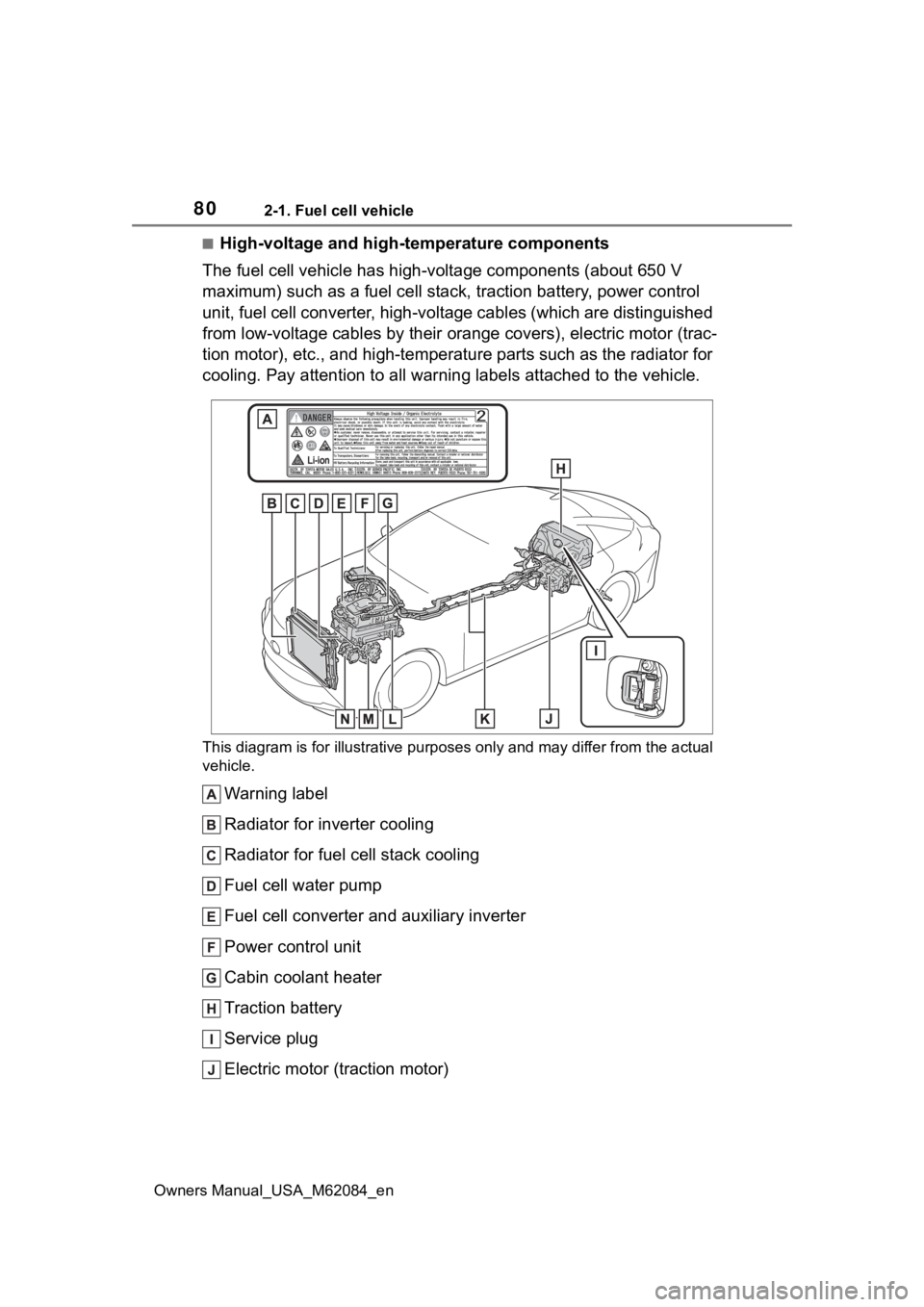
802-1. Fuel cell vehicle
Owners Manual_USA_M62084_en
■High-voltage and high-temperature components
The fuel cell vehicle has high-voltage components (about 650 V
maximum) such as a fuel cell stack, traction battery, power con trol
unit, fuel cell converter, high-voltage cables (which are distinguished
from low-voltage cables by their orange covers), electric motor (trac-
tion motor), etc., and high-temperature parts such as the radiator for
cooling. Pay attention to all w arning labels attached to the vehicle.
This diagram is for illustrative purposes only and may differ f rom the actual
vehicle.
Warning label
Radiator for inverter cooling
Radiator for fuel cell stack cooling
Fuel cell water pump
Fuel cell converter and auxiliary inverter
Power control unit
Cabin coolant heater
Traction battery
Service plug
Electric motor (traction motor)
Page 389 of 556
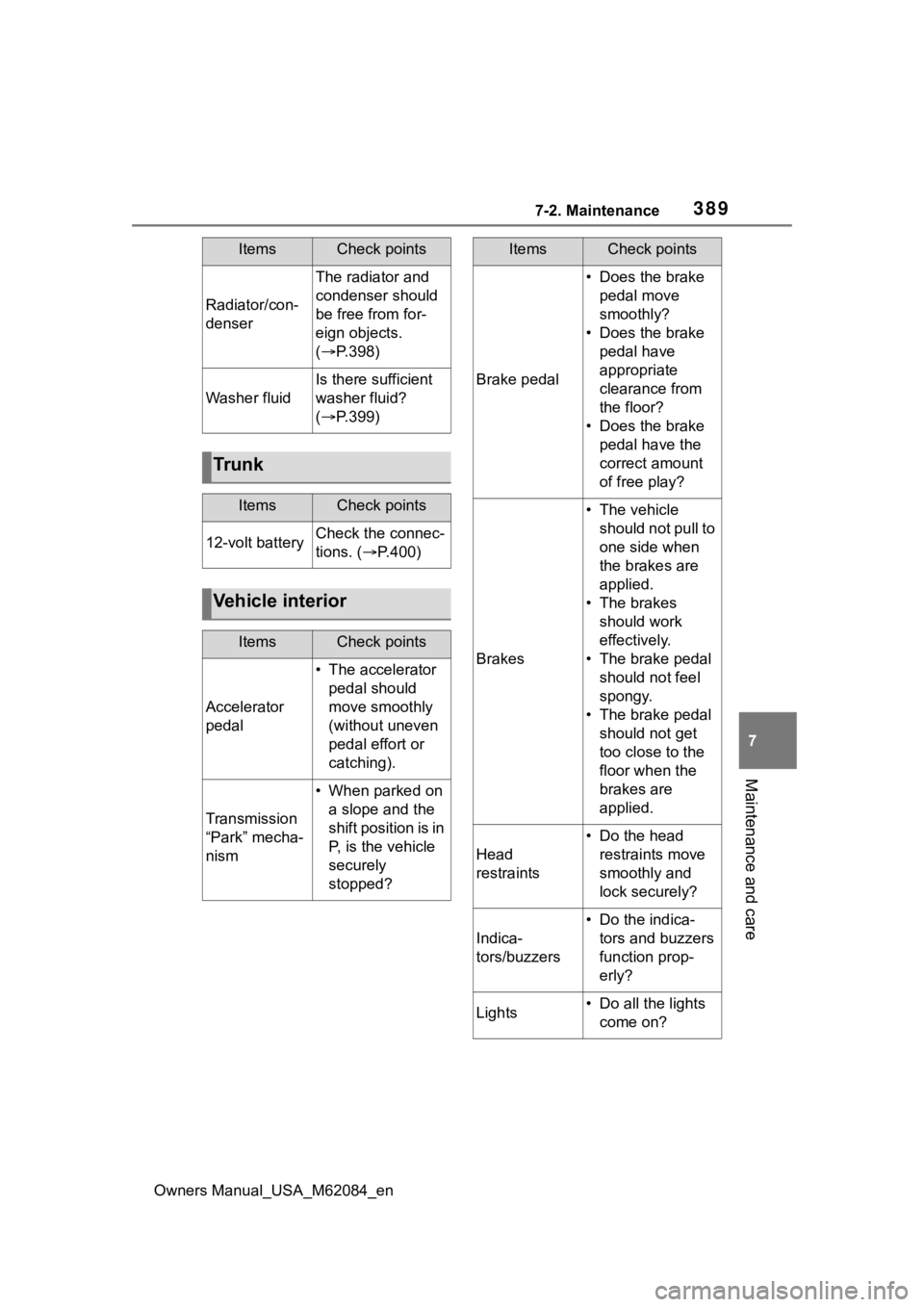
3897-2. Maintenance
Owners Manual_USA_M62084_en
7
Maintenance and care
Radiator/con-
denser
The radiator and
condenser should
be free from for-
eign objects.
( P.398)
Washer fluid
Is there sufficient
washer fluid?
( P.399)
Trun k
ItemsCheck points
12-volt batteryCheck the connec-
tions. ( P.400)
Vehicle interior
ItemsCheck points
Accelerator
pedal
• The accelerator
pedal should
move smoothly
(without uneven
pedal effort or
catching).
Transmission
“Park” mecha-
nism
• When parked on a slope and the
shift position is in
P, is the vehicle
securely
stopped?
ItemsCheck points
Brake pedal
• Does the brake pedal move
smoothly?
• Does the brake pedal have
appropriate
clearance from
the floor?
• Does the brake pedal have the
correct amount
of free play?
Brakes
• The vehicle should not pull to
one side when
the brakes are
applied.
• The brakes should work
effectively.
• The brake pedal should not feel
spongy.
• The brake pedal should not get
too close to the
floor when the
brakes are
applied.
Head
restraints
• Do the head restraints move
smoothly and
lock securely?
Indica-
tors/buzzers
• Do the indica-tors and buzzers
function prop-
erly?
Lights• Do all the lights come on?
ItemsCheck points
Page 391 of 556
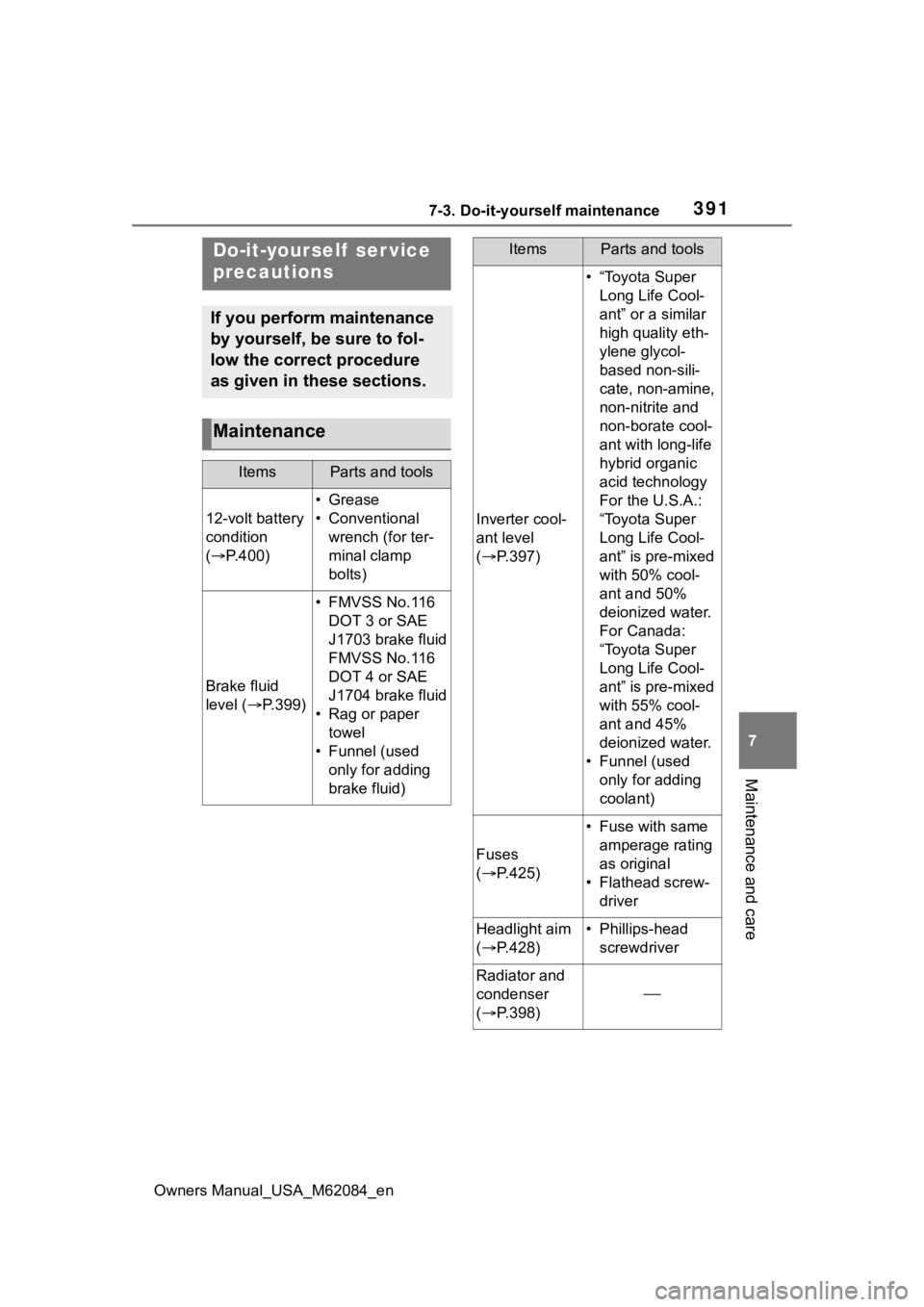
3917-3. Do-it-yourself maintenance
Owners Manual_USA_M62084_en
7
Maintenance and care
7-3.Do-it-yourself maintenance
Do-it-yourself ser vice
precautions
If you perform maintenance
by yourself, be sure to fol-
low the correct procedure
as given in these sections.
Maintenance
ItemsParts and tools
12-volt battery
condition
( P.400)
•Grease
• Conventional
wrench (for ter-
minal clamp
bolts)
Brake fluid
level ( P.399)
• FMVSS No.116
DOT 3 or SAE
J1703 brake fluid
FMVSS No.116
DOT 4 or SAE
J1704 brake fluid
• Rag or paper towel
• Funnel (used only for adding
brake fluid)
Inverter cool-
ant level
( P.397)
• “Toyota Super
Long Life Cool-
ant” or a similar
high quality eth-
ylene glycol-
based non-sili-
cate, non-amine,
non-nitrite and
non-borate cool-
ant with long-life
hybrid organic
acid technology
For the U.S.A.:
“Toyota Super
Long Life Cool-
ant” is pre-mixed
with 50% cool-
ant and 50%
deionized water.
For Canada:
“Toyota Super
Long Life Cool-
ant” is pre-mixed
with 55% cool-
ant and 45%
deionized water.
• Funnel (used only for adding
coolant)
Fuses
( P.425)
• Fuse with same
amperage rating
as original
• Flathead screw- driver
Headlight aim
( P.428)• Phillips-head
screwdriver
Radiator and
condenser
( P.398)
ItemsParts and tools
Page 392 of 556
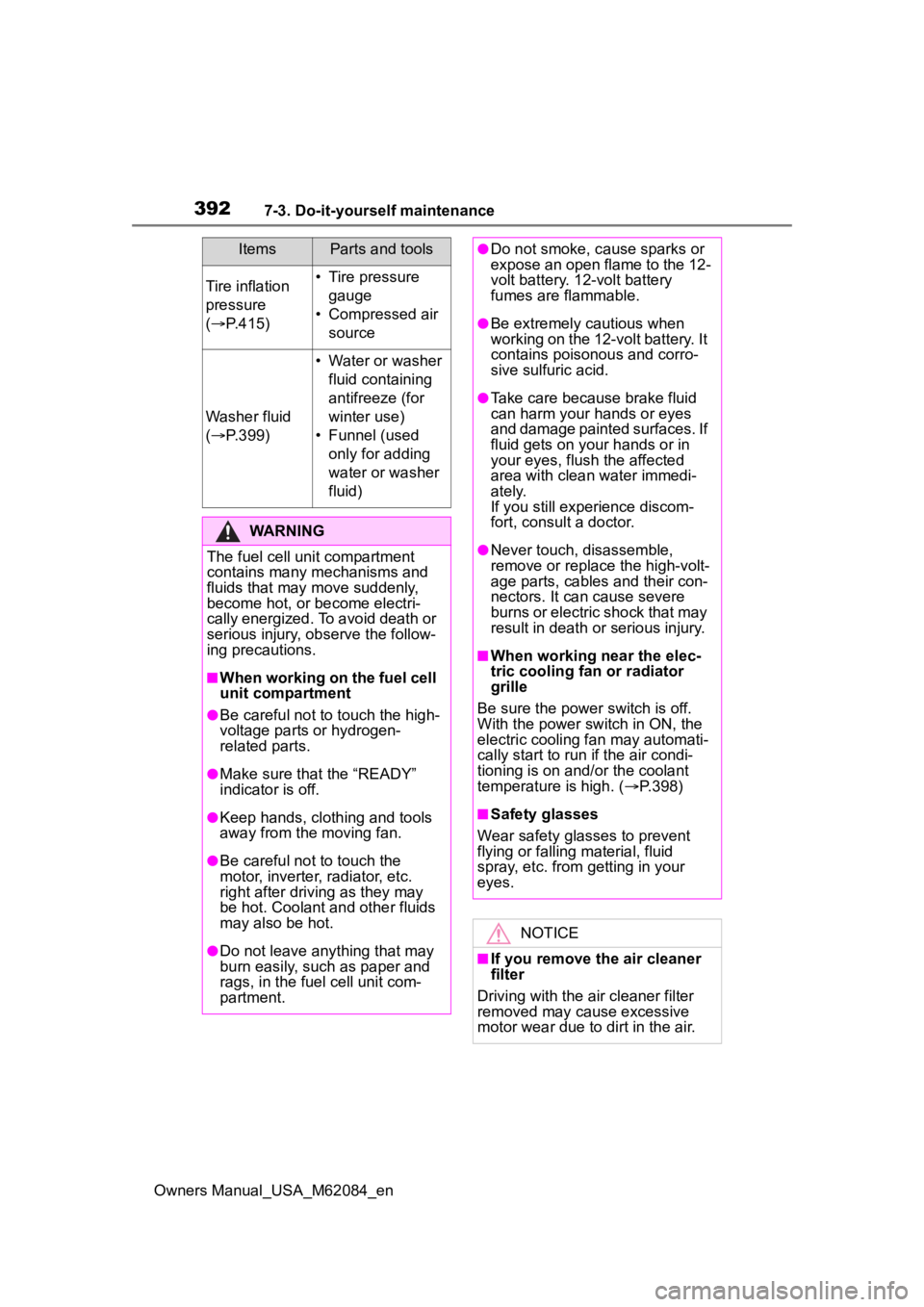
3927-3. Do-it-yourself maintenance
Owners Manual_USA_M62084_en
Tire inflation
pressure
( P.415)• Tire pressure
gauge
• Compressed air source
Washer fluid
( P.399)
• Water or washer
fluid containing
antifreeze (for
winter use)
• Funnel (used only for adding
water or washer
fluid)
WARNING
The fuel cell unit compartment
contains many mechanisms and
fluids that may move suddenly,
become hot, or become electri-
cally energized. To avoid death or
serious injury, observe the follow-
ing precautions.
■When working on the fuel cell
unit compartment
●Be careful not to touch the high-
voltage parts or hydrogen-
related parts.
●Make sure that the “READY”
indicator is off.
●Keep hands, clothing and tools
away from the moving fan.
●Be careful not to touch the
motor, inverter, radiator, etc.
right after driving as they may
be hot. Coolant and other fluids
may also be hot.
●Do not leave anything that may
burn easily, such as paper and
rags, in the fuel cell unit com-
partment.
ItemsParts and tools●Do not smoke, cause sparks or
expose an open flame to the 12-
volt battery. 12-volt battery
fumes are flammable.
●Be extremely cautious when
working on the 12-volt battery. It
contains poisonous and corro-
sive sulfuric acid.
●Take care because brake fluid
can harm your hands or eyes
and damage painted surfaces. If
fluid gets on your hands or in
your eyes, flush the affected
area with clean water immedi-
ately.
If you still experience discom-
fort, consult a doctor.
●Never touch, disassemble,
remove or replace the high-volt-
age parts, cables and their con-
nectors. It can cause severe
burns or electric shock that may
result in death or serious injury.
■When working near the elec-
tric cooling fan or radiator
grille
Be sure the power switch is off.
With the power switch in ON, the
electric cooling fa n may automati-
cally start to run if the air condi-
tioning is on and/or the coolant
temperature is high. ( P.398)
■Safety glasses
Wear safety glasses to prevent
flying or falling material, fluid
spray, etc. from getting in your
eyes.
NOTICE
■If you remove the air cleaner
filter
Driving with the air cleaner filter
removed may cause excessive
motor wear due to dirt in the air.
Page 395 of 556
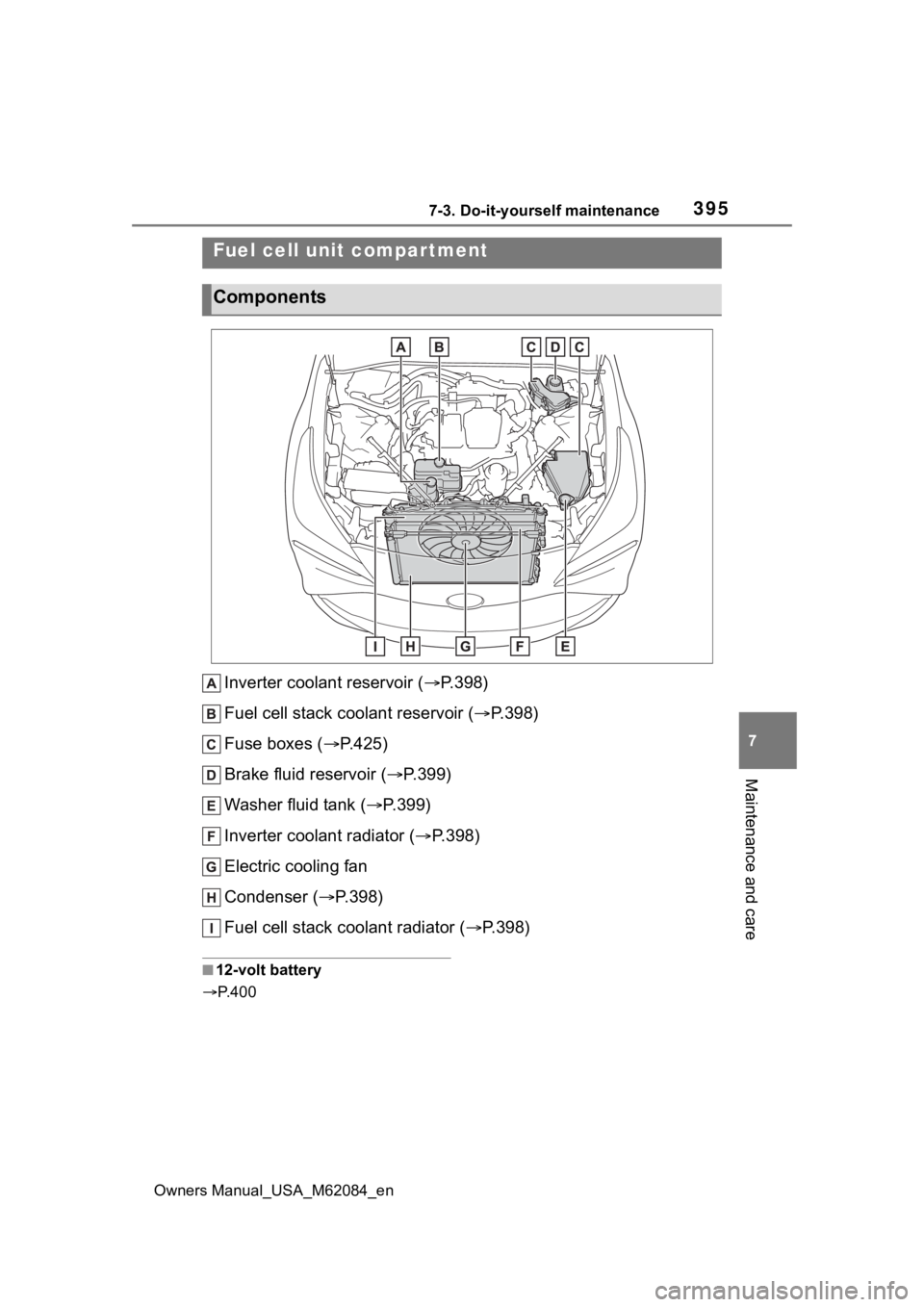
3957-3. Do-it-yourself maintenance
Owners Manual_USA_M62084_en
7
Maintenance and care
Inverter coolant reservoir ( P.398)
Fuel cell stack coolant reservoir ( P.398)
Fuse boxes ( P.425)
Brake fluid reservoir ( P.399)
Washer fluid tank ( P.399)
Inverter coolant radiator ( P.398)
Electric cooling fan
Condenser ( P.398)
Fuel cell stack coolant radiator ( P.398)
■12-volt battery
P. 4 0 0
Fuel cell unit compartment
Components
Page 398 of 556
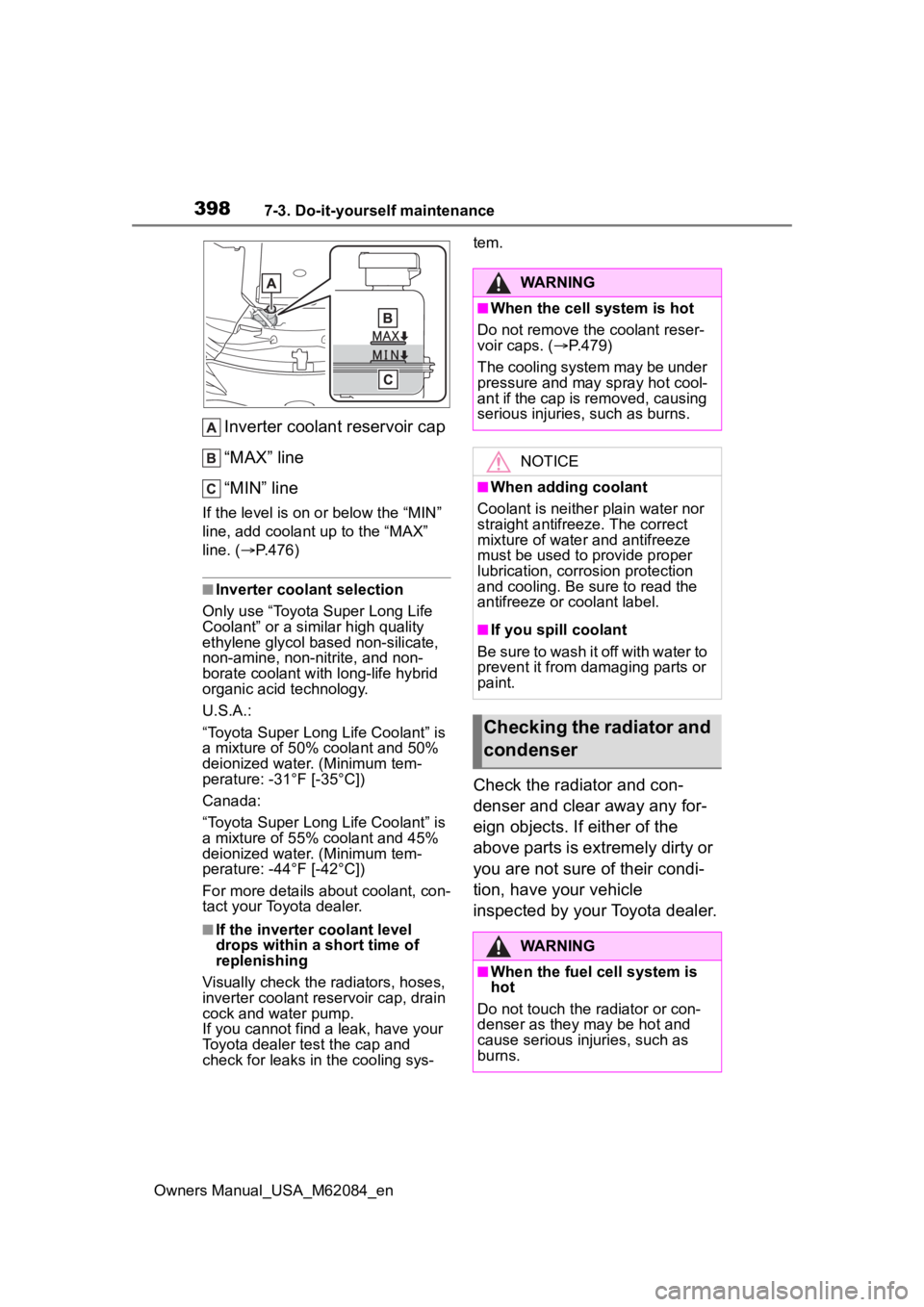
3987-3. Do-it-yourself maintenance
Owners Manual_USA_M62084_en
Inverter coolant reservoir cap
“MAX” line
“MIN” line
If the level is on or below the “MIN”
line, add coolant up to the “MAX”
line. (P.476)
■Inverter coolant selection
Only use “Toyota Super Long Life
Coolant” or a similar high quality
ethylene glycol based non-silicate,
non-amine, non-nitrite, and non-
borate coolant with long-life hybrid
organic acid technology.
U.S.A.:
“Toyota Super Long Life Coolant” is
a mixture of 50% coolant and 50%
deionized water. (Minimum tem-
perature: -31°F [-35°C])
Canada:
“Toyota Super Long Life Coolant” is
a mixture of 55% coolant and 45%
deionized water. (Minimum tem-
perature: -44°F [-42°C])
For more details about coolant, con-
tact your Toyota dealer.
■If the inverter coolant level
drops within a short time of
replenishing
Visually check the radiators, hoses,
inverter coolant reservoir cap, drain
cock and water pump.
If you cannot find a leak, have your
Toyota dealer test the cap and
check for leaks in the cooling sys- tem.
Check the radiator and con-
denser and clear away any for-
eign objects. If either of the
above parts is extremely dirty or
you are not sure of their condi-
tion, have your vehicle
inspected by your Toyota dealer.
WARNING
■When the cell system is hot
Do not remove the coolant reser-
voir caps. ( P.479)
The cooling system may be under
pressure and may spray hot cool-
ant if the cap is removed, causing
serious injuries, such as burns.
NOTICE
■When adding coolant
Coolant is neither plain water nor
straight antifreeze. The correct
mixture of water and antifreeze
must be used to provide proper
lubrication, corrosion protection
and cooling. Be sure to read the
antifreeze or coolant label.
■If you spill coolant
Be sure to wash it off with water to
prevent it from damaging parts or
paint.
Checking the radiator and
condenser
WARNING
■When the fuel cell system is
hot
Do not touch the radiator or con-
denser as they may be hot and
cause serious injuries, such as
burns.
Page 477 of 556
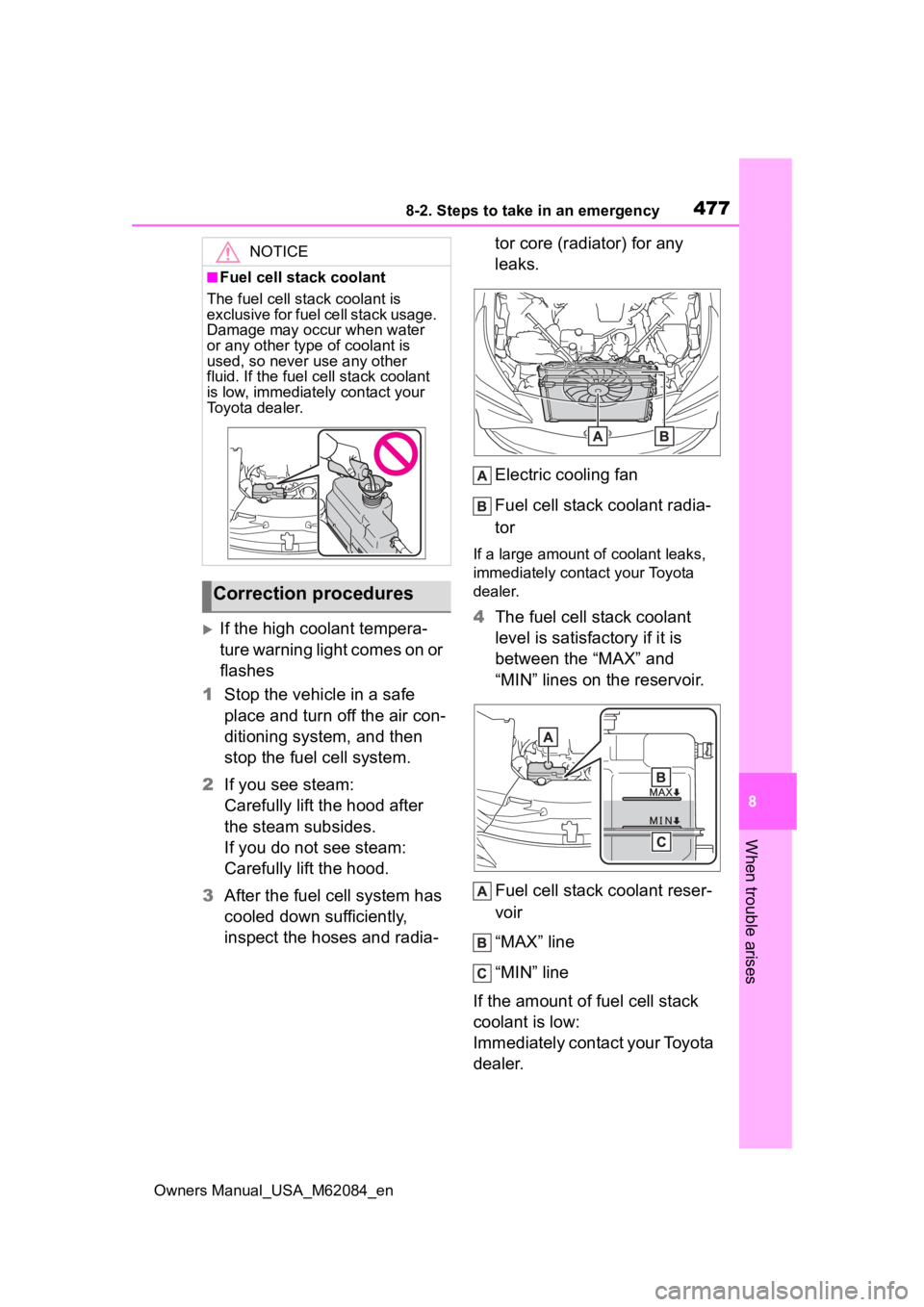
4778-2. Steps to take in an emergency
Owners Manual_USA_M62084_en
8
When trouble arises
If the high coolant tempera-
ture warning light comes on or
flashes
1 Stop the vehicle in a safe
place and turn off the air con-
ditioning system, and then
stop the fuel cell system.
2 If you see steam:
Carefully lift the hood after
the steam subsides.
If you do not see steam:
Carefully lift the hood.
3 After the fuel cell system has
cooled down sufficiently,
inspect the hoses and radia- tor core (radiator) for any
leaks.
Electric cooling fan
Fuel cell stack coolant radia-
tor
If a large amount of coolant leaks,
immediately contact your Toyota
dealer.
4
The fuel cell stack coolant
level is satisfactory if it is
between the “MAX” and
“MIN” lines on the reservoir.
Fuel cell stack coolant reser-
voir
“MAX” line
“MIN” line
If the amount of fuel cell stack
coolant is low:
Immediately contact your Toyota
dealer.
NOTICE
■Fuel cell stack coolant
The fuel cell stack coolant is
exclusive for fuel cell stack usage.
Damage may occur when water
or any other type of coolant is
used, so never use any other
fluid. If the fuel cell stack coolant
is low, immediately contact your
Toyota dealer.
Correction procedures
Page 478 of 556
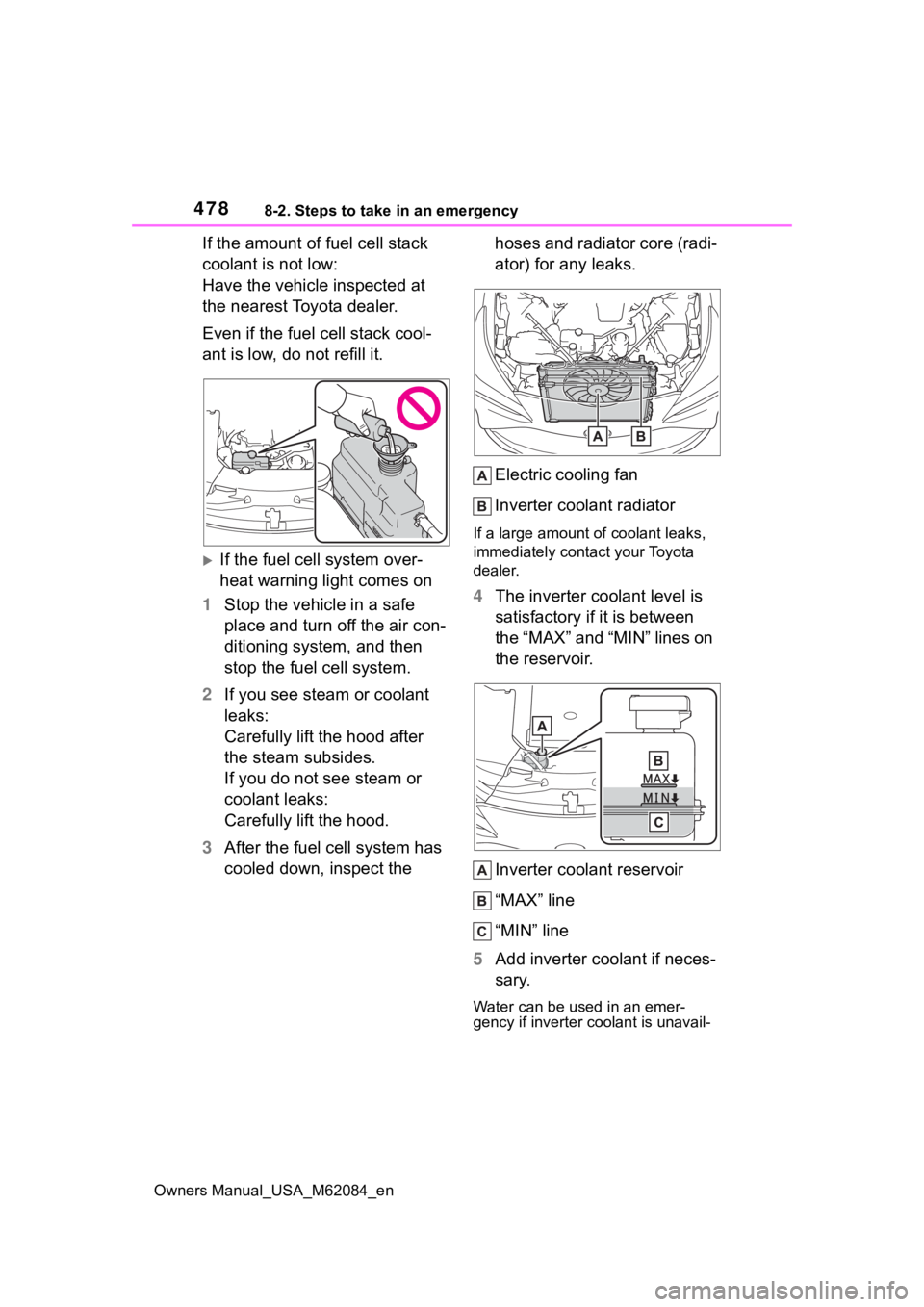
4788-2. Steps to take in an emergency
Owners Manual_USA_M62084_en
If the amount of fuel cell stack
coolant is not low:
Have the vehicle inspected at
the nearest Toyota dealer.
Even if the fuel cell stack cool-
ant is low, do not refill it.
If the fuel cell system over-
heat warning light comes on
1 Stop the vehicle in a safe
place and turn off the air con-
ditioning system, and then
stop the fuel cell system.
2 If you see steam or coolant
leaks:
Carefully lift the hood after
the steam subsides.
If you do not see steam or
coolant leaks:
Carefully lift the hood.
3 After the fuel cell system has
cooled down, inspect the hoses and radiator core (radi-
ator) for any leaks.
Electric cooling fan
Inverter coolant radiator
If a large amount of coolant leaks,
immediately contact your Toyota
dealer.
4
The inverter coolant level is
satisfactory if it is between
the “MAX” and “MIN” lines on
the reservoir.
Inverter coolant reservoir
“MAX” line
“MIN” line
5 Add inverter coolant if neces-
sary.
Water can be used in an emer-
gency if inverter coolant is unavail-
Page 479 of 556
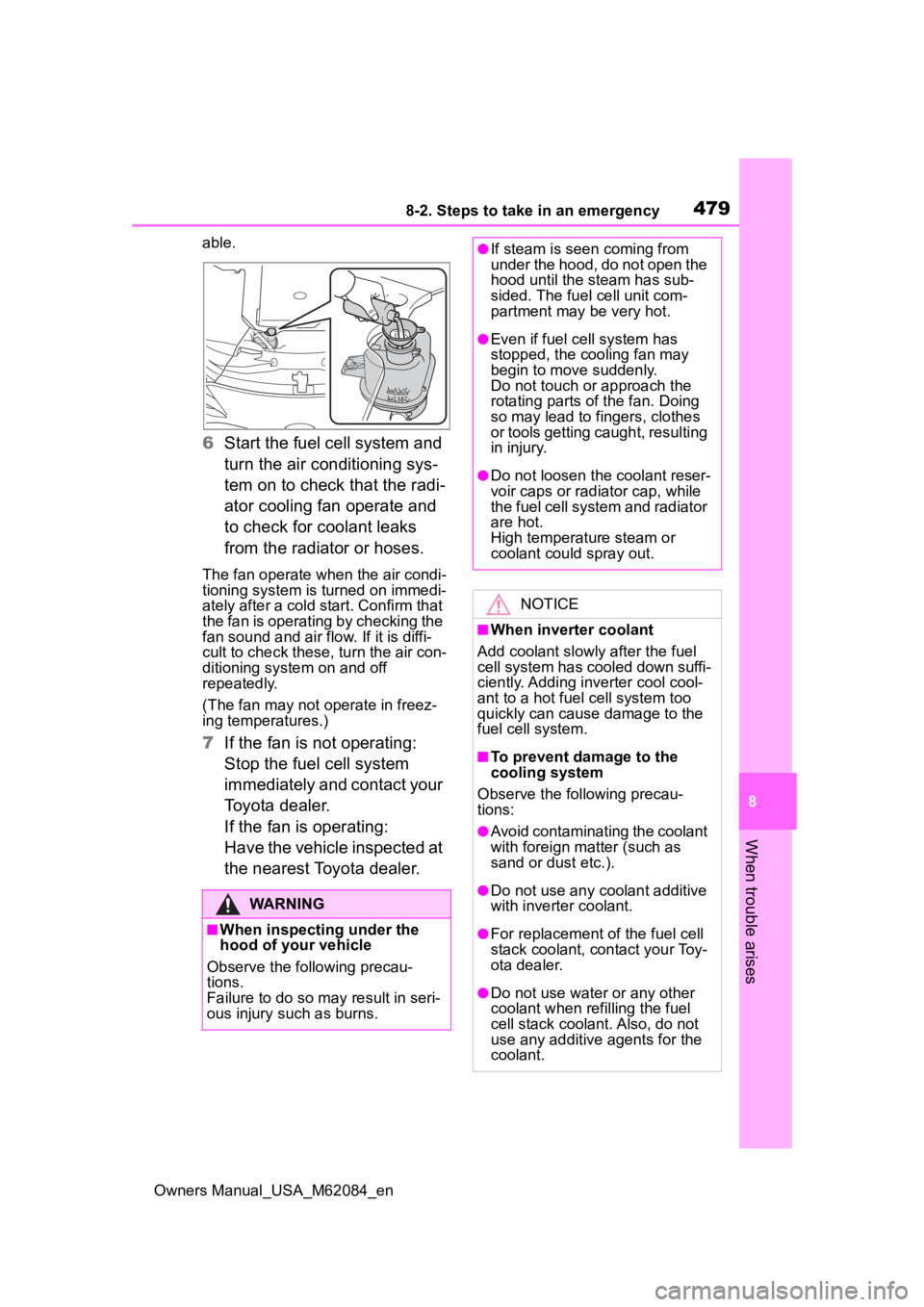
4798-2. Steps to take in an emergency
Owners Manual_USA_M62084_en
8
When trouble arises
able.
6 Start the fuel cell system and
turn the air conditioning sys-
tem on to check that the radi-
ator cooling fan operate and
to check for coolant leaks
from the radiator or hoses.
The fan operate when the air condi-
tioning system is turned on immedi-
ately after a cold s tart. Confirm that
the fan is operating by checking the
fan sound and air flow. If it is diffi-
cult to check these, turn the air con-
ditioning system on and off
repeatedly.
(The fan may not o perate in freez-
ing temperatures.)
7 If the fan is not operating:
Stop the fuel cell system
immediately and contact your
Toyota dealer.
If the fan is operating:
Have the vehicle inspected at
the nearest Toyota dealer.
WARNING
■When inspecting under the
hood of your vehicle
Observe the following precau-
tions.
Failure to do so may result in seri-
ous injury such as burns.
●If steam is seen coming from
under the hood, do not open the
hood until the steam has sub-
sided. The fuel cell unit com-
partment may be very hot.
●Even if fuel cell system has
stopped, the cooling fan may
begin to move suddenly.
Do not touch or approach the
rotating parts of the fan. Doing
so may lead to fingers, clothes
or tools getting caught, resulting
in injury.
●Do not loosen the coolant reser-
voir caps or radia tor cap, while
the fuel cell system and radiator
are hot.
High temperature steam or
coolant could spray out.
NOTICE
■When inverter coolant
Add coolant slowly after the fuel
cell system has cooled down suffi-
ciently. Adding inverter cool cool-
ant to a hot fuel cell system too
quickly can cause damage to the
fuel cell system.
■To prevent damage to the
cooling system
Observe the following precau-
tions:
●Avoid contaminating the coolant
with foreign matter (such as
sand or dust etc.).
●Do not use any coolant additive
with inverter coolant.
●For replacement of the fuel cell
stack coolant, contact your Toy-
ota dealer.
●Do not use water or any other
coolant when refilling the fuel
cell stack coolant. Also, do not
use any additive agents for the
coolant.
Page 485 of 556
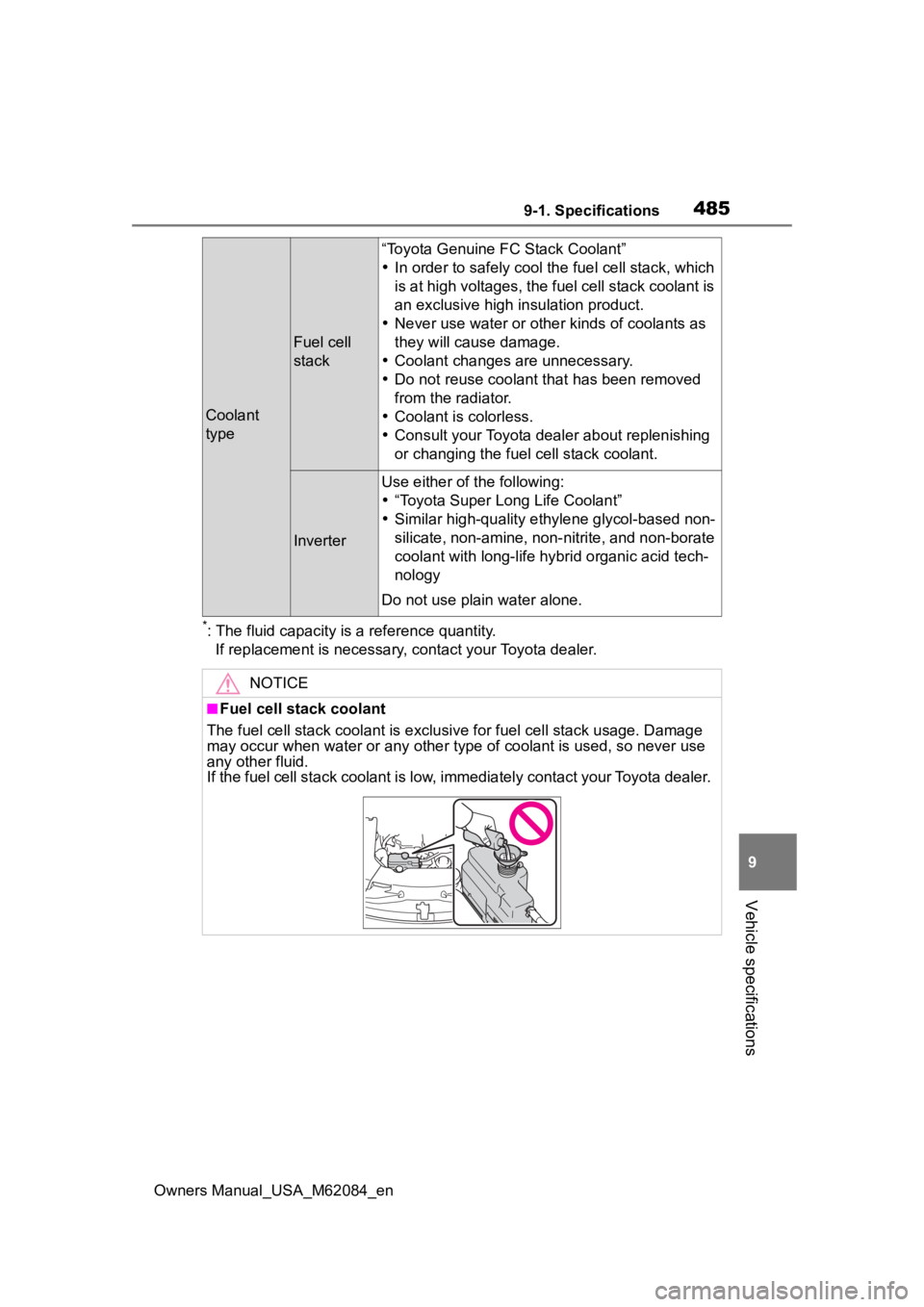
4859-1. Specifications
Owners Manual_USA_M62084_en
9
Vehicle specifications
*: The fluid capacity is a reference quantity. If replacement is necessary, contact your Toyota dealer.
Coolant
type
Fuel cell
stack
“Toyota Genuine FC Stack Coolant”
In order to safely cool the fuel cell stack, which
is at high voltages, the fuel cell stack coolant is
an exclusive high insulation product.
Never use water or other kinds of coolants as
they will cause damage.
Coolant changes are unnecessary.
Do not reuse coolant that has been removed
from the radiator.
Coolant is colorless.
Consult your Toyota deale r about replenishing
or changing the fuel cell stack coolant.
Inverter
Use either of the following:
“Toyota Super Long Life Coolant”
Similar high-quality ethylene glycol-based non-
silicate, non-amine, non- nitrite, and non-borate
coolant with long-life hybrid org anic acid tech-
nology
Do not use plain water alone.
NOTICE
■Fuel cell stack coolant
The fuel cell stack coolant is e xclusive for fuel cell stack usage. Damage
may occur when water or any other type of coolant is used, so n ever use
any other fluid.
If the fuel cell stack coolant is low, immediately contact your Toyota dealer.